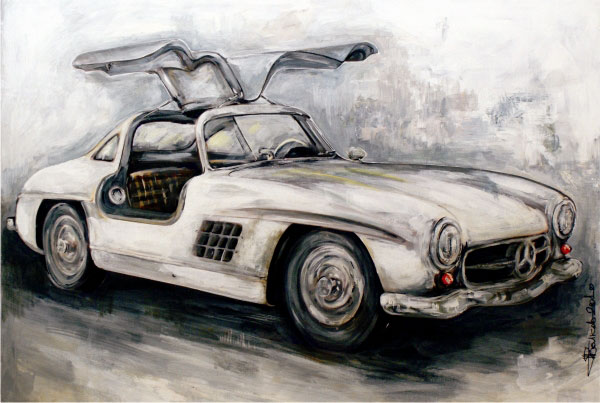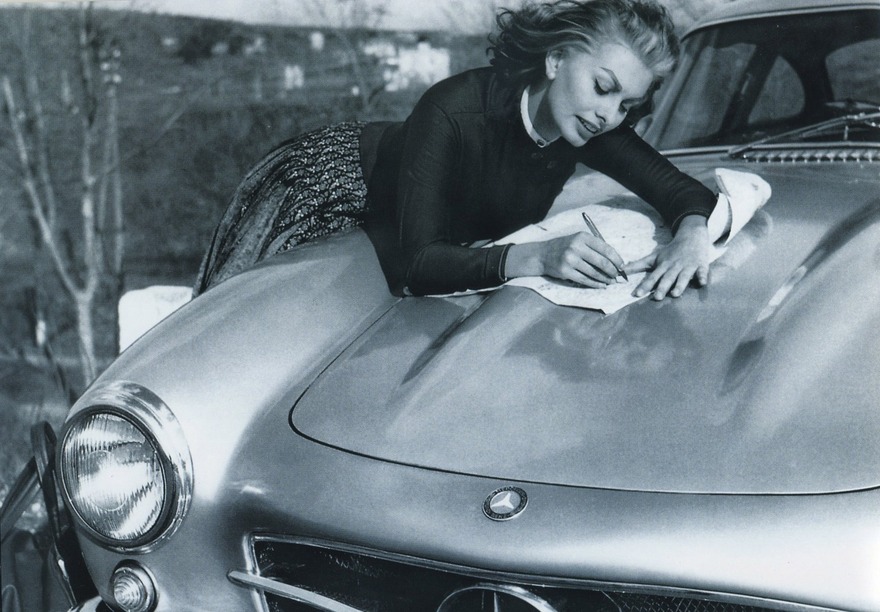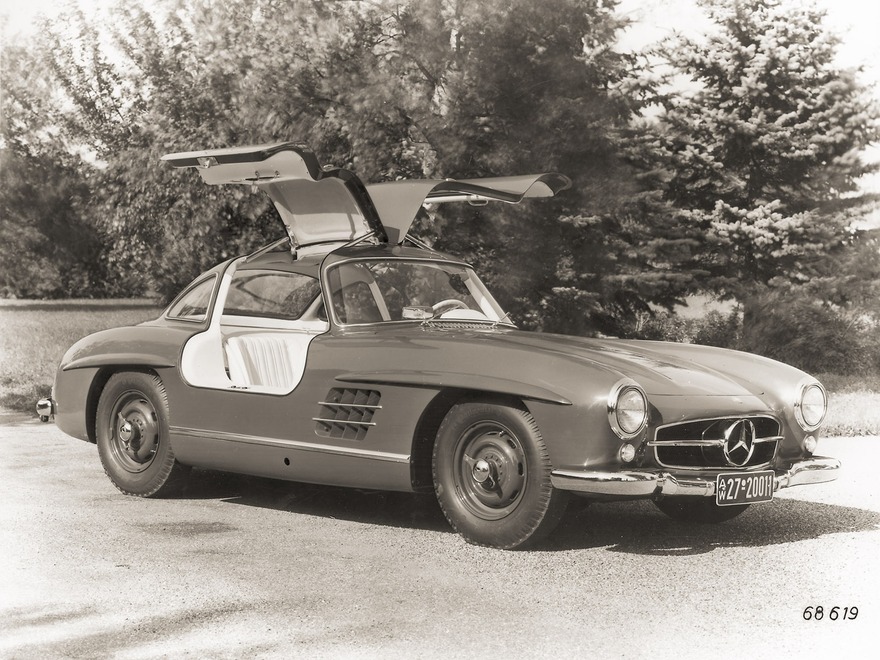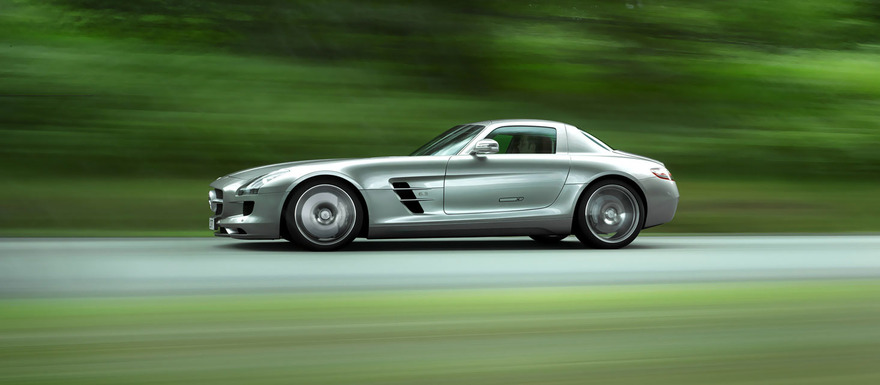This story began in the suburbs of Stuttgart. Wilhelm Maybach, the engineer who later became a great figure and authority in global car industry, designed a car fitted with a four-cylinder engine producing 35 hp. Just one unit. It was a two-seat racing car named after the daughter of Emil Jellinik, one of company’s cofounders, who was a real motor sport enthusiast. And her name was Mercedes. Ever since all models produced by the Daimler company were bearing the name of Mercedes, which was registered as a trade name in 1902. And Maybach had tied his name with the history of Mercedes-Benz forever.
The first sports car brought into life by the company was the legendary Mercedes 300SL W198 Gullwing. It was revealed in the post-war years to the thrilled audience at the prestigious New York Auto Show. It was predetermined for this premiere to win fame both on the tracks and in the hearts of its admirers. In the 50s 300SL was perceived by the German people as one of the symbols of a resurrecting country which had been defeated and divided into parts after the war.
The epoch of the Gullwing began in 1952 when Mercedes-Benz W194 racing cars started scoring one victory after another. It was designed by Rudolf Uhlenhaut, the famous developing engineer. The car was fitted with all kinds of technical innovations and specialties available at that time. Work on design projects began in September 1953 on request of Maximilian Hoffman, importer of Mercedes-Benz automobiles into the United States. Initially, the 300SL model was not intended to become a production vehicle; however, the Daimler-Benz board members had to take Hoffman’s opinion into account. The latter persuaded directors from Stuttgart to develop a street-legal version of the sports car by assuring them that he would be able to find at least 1,000 customers straight away. The question was being considered for quite a long time but finally the company made a decision to launch production of the street-legal version of the 300SL model with the W198 chassis.

By securing top places in plenty of competitions, 300SL provided a decent continuation to the sports traditions set by its sibling. It secured victory in its class at the Mille Miglia competitions in 1955 and the same year Olivier Gendebien and Pierre Stasse drove the Mercedes-Benz 300SL to the victory in the Liège-Rome-Liège Rally. This car also helped three drivers from Europe and the USA to become champions — Werner Engel won the European touring car championship in 1955 and Walter Schock did it in 1956. In the USA Paul O’Shea clinched the American Sports Car Champion’s title in Production Class D both in 1955 and 1956 leaving his competitors far behind.
The model’s engine delivered 215 hp. Instead of the M194’s 6-cylinder 3-litre in-line carburettor engine producing 129 kW, the W198 was equipped with a 158-kW direct injection borrowed from the M198 model. The engine was installed at an angle providing the car with almost flat front part and outstanding aerodynamic characteristics. Focus on making the entire construction very light provided the vehicle with great performance. For instance, it allowed reaching 250 km/h of top speed in compliance with the rear-axle ratio. Its framework was almost the same as the one used for the 300 sedan (W186); however, its suspension settings were adjusted to fit a sports car.

The cabin of the 300SL roadster was both simple and sophisticated. Although its sports predecessor was made of aluminium, the bodyshell of the production vehicle was produced out of high-quality sheet steel except for the bonnet, trunk lid, sills and doors — they were made of «flying» metal. The tubular frame weighed only 80 kg and the weight of the entire car was 1,295 kg. Initially, it was suggested to make a coupé with two gull-wing doors but in 1957 the model was turned into a roadster. The front part of the car became longer, the radiator grille was changed and headlights were modified. Door hinges were relocated to the regular positions and a possibility was found to make the door sills lower. When purchasing a Mercedes-Benz 300SL, the customer could opt for the modified transmission. Everyone wanted to become a customer; however, the Gullwing turned out to be really exclusive. Around 1,400 units of the Mercedes-Benz 300SL were built in the German town of Sindelfingen from August 1954 through May 1957, including 29 vehicles with light-alloy bodies and also one experimental car with plastic body. The price of the 300SL was 29,000 German marks and $7,500 in the USA like some of the Cadillac automobiles. All in all, 1,400 coupés and 1,858 roadsters rolled off the production lines.
Among the owners of luxurious Mercedes cars one could find the one and only Elvis Presley, Prince Sadruddin Aga Khan, a great man of art and a talented painter Pablo Picasso, Zsa Zsa Gabor and many other prominent people. The car demonstrated excellent speed performance. From time to time it lacked some control in cornering due to its obvious tendency to skidding; however, a good driver could easily handle the hot temper of this beautiful car and enjoy driving it.
It is worth mentioning that the DaimlerChrysler company built a special version of its popular SL successor to celebrate the 50th anniversary of the legendary roadster. The fortunate few became the owners of the commemorative Mercedes SL500 and Mercedes SL350 from the “Edition 50” series (Mercedes-Benz SL-Klasse Edition 50) — rare cars with the price tag higher than the nominal one.
Their only difference from the standard versions except for the on-board computer (the latest version of the COMAND APS) lies in using what might be called the “bells and whistles” like leather dashboard with indicators made of polished aluminium and brushed steel or the tinted rear lights. But one may also agree that it has some certain SL-style spirit which had always accompanied the Mercedes-Benz 300SL cars throughout their glorious history. And it seems the story doesn’t end here.
According to the information published by the Leftlinenews news feed with reference to the German AutoBild magazine, Mercedes has plans to revive the 300SL Gullwing coupé which would become the ideological successor of the legendary car of the mid-50s. Like the car which appeared more than 50 years ago, the new Mercedes 300SL Gullwing will be equipped with the upward opening gull-wing doors.
In all other respects, the exterior of the new Mercedes will be featuring a modern design resembling the legendary Mercedes-Benz 300SL — “inspired by” as one might say. The Gullwing became a legend long before the model was taken out of production. And for more than half a century it has been among the most desirable and honoured rare cars in the world.
Photo: www.free-lancers.net, www.auto-tuning-news.com, www.ru.autowp.ru, www.hotwalls.ru, www.cardesign.ru











